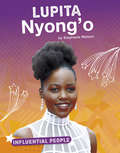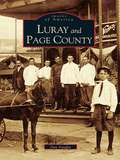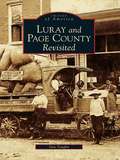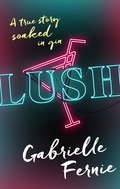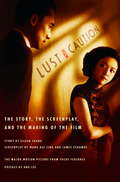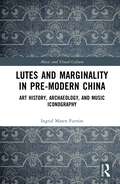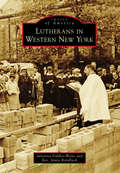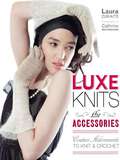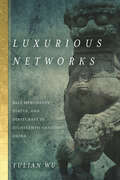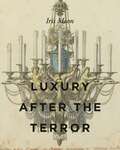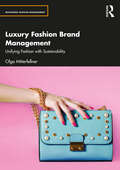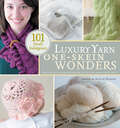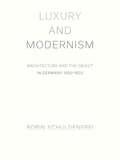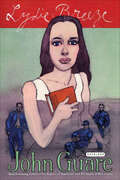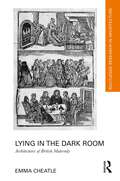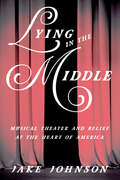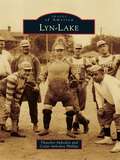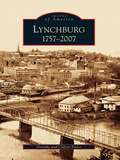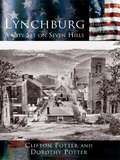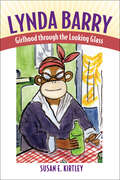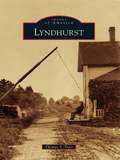- Table View
- List View
Lupita Nyong'o (Influential People)
by Stephanie WatsonWhen Lupita Nyong'o was a young girl, she didn't think she could be a famous actor. Now she is an Academy Award winner. Learn more about her rise to stardom!
Luray and Page County (Images of America)
by Dan VaughnFormed out of necessity in 1831, Page County had a great need to operate within its own boundaries of the Massanutten and Blue Ridge Mountains. A very unique situation arose when this rural area was coupled with the discovery in 1878 of something as spectacular as the Luray Caverns. Along with this new fame followed a large influx of tourists, industry, and varied commerce into the entire county from the lifeline created by the formation of the Shenandoah Valley Railroad in 1881. During the reconstruction years after the Civil War, and with the formation of "land and improvement" companies throughout the United States, Page County, along with the rest of the country, was booming. In fact, this unbridled growth was happening much too fast for this newly reformed country. This in turn brought about a severe recession in the 1890s that affected everyone, including the people of Page, no matter how secure they may have seemed with their new attraction. The culmination of these events initiated a quaint photographic history that is contained within the pages of Images of America: Luray and Page County.
Luray and Page County Revisited
by Dan VaughnLuray Caverns, discovered in the quiet valley community of Luray in 1878, became the main attraction in Page County. In hopes of capitalizing on this new found "Wonder of the World," executives of the Shenandoah Valley Railroad completed the rail from Hagerstown and Basic City to Luray by 1881. Mann Almond drove the final ceremonial spike just north of Deford's Tannery in Luray. With the arrival of the railroad came a new economy supported by passengers, excursionists, lodging, and freight transport. The bulk of these transports were Eureka Mining Company's mineral extractions and Shenandoah's "BigGem" iron bloom shipments. Luray's own "Mercantile Mile" leading to the caverns was laden with storehouses, offering goods found in larger cities, and the rail brought visitors in droves. The photographers who produced the images contained here did so only as a means of income, but today their work is our visual link to the past.
Lush: A True Story, Soaked in Gin
by Gabrielle Fernie'FRANK, FILTHY and FEROCIOUSLY FUNNY' Sunday Mirror'I loved every HONEST and HILARIOUS second!' Carrie Hope Fletcher 'Made me CACKLE OUT LOUD on every single page' Daisy BuchananLush (adj.) Very rich and providing great sensory pleasure (Oxford English Dictionary) (n.) A habitual drunkard (Oxford English Dictionary)Gabby and Emma have been best friends since primary school in Wales. Emma has a stable job, a nice home and has just got engaged. Gabby has had a succession of disastrous one-night stands and awful jobs since drama school . . . and she has just been diagnosed with scurvy. She has one year until the wedding to pull herself together and prove to her friends and family that she can be a proper grown-up.Described by Caitlin Moran as 'filthy, immoral and incredibly funny', Gabrielle Fernie's blog, loveisa4letterturd.com, catalogued her life as a struggling actress with a taste for gin. Here, in her first book, she shares her most raucous stories with eye-watering honesty. It is a laugh-out-loud account of a young woman trying to find her place in the world.Readers love Lush:'Best book I have read for a very long time! Absolutely hilarious!' 'Thanks for making me laugh out loud on the tube like a weirdo and for making me miss my stop more than once''Moments of true absurdity partnered with genuinely touching stories of friendship in your twenties makes for an excellent read' 'I would recommend this book to anyone who's ever doubted themselves; as a little reminder that no matter how ridiculous your life seems to have become, Gabrielle Fernie's has always been hilariously and irrevocably far, far worse'
Lust, Caution
by Eileen Chang Wang Hui LingNow a major motion picture from Oscar-winning director Ang Lee (Crouching Tiger, Hidden Dragon, Brokeback Mountain): an intensely passionate story of love and espionage, set in Shanghai during World War II.In the midst of the Japanese occupation of China and Hong Kong, two lives become intertwined: Wong Chia Chi, a young student active in the resistance, and Mr. Yee, a powerful political figure who works for the Japanese occupational government. As these two move deftly between Shanghai's tea parties and secret interrogations, they become embroiled in the complicated politics of wartime -- and in a mutual attraction that may be more than what they expected. Written in lush, lavish prose, and with the tension of a political thriller, Lust, Caution brings 1940s Shanghai artfully to life even as it limns the erotic pulse of a doomed love affair.From the Trade Paperback edition.
Lutes and Marginality in Pre-Modern China: Art History, Archaeology, and Music Iconography (Music and Visual Culture)
by Ingrid Maren FurnissLutes and Marginality in Pre-Modern China traces the complex history of lutes as they moved from the far west into China, and how these instruments became linked to various forms of social, cultural, ethnic, and religious marginality within and at China’s borders.The book argues that the lute, a musical instrument that likely originated in the Near East or Central Asia, became a highly charged object replete with associations of ethnic and political identity, social status, and gender in China across the third to seventeenth centuries, and as such, offers a crucial vehicle for understanding interactions between the Chinese center and periphery. Using a richly interdisciplinary perspective that brings together music history, performance studies, archaeology, and art history, the author draws together the visual evidence for the history of Chinese lutes and analyzes the political and cultural dimensions of their depictions in art. In exploring the lute’s reception across time and space, this book illuminates the shifting relationships between China and cultures along its frontier, as well as the dynamics of gender and social status within China’s center.Comprehensive in scope, Lutes and Marginality in Pre-Modern China offers new insights for scholars of pre-modern China, art history, archaeology, music history, ethnomusicology, and Silk Road and frontier studies.
Lutheran Churches in Early Modern Europe
by Andrew SpicerUntil recently the impact of the Lutheran Reformation has been largely regarded in political and socio-economic terms, yet for most people it was not the abstract theological debates that had the greatest impact upon their lives, but what they saw in their parish churches every Sunday. This collection of essays provides a coherent and interdisciplinary investigation of the impact that the Lutheran Reformation had on the appearance, architecture and arrangement of early modern churches. Drawing upon recent research being undertaken by leading art historians and historians on Lutheran places of worship, the volume emphasises often surprising levels of continuity, reflecting the survival of Catholic fixtures, fittings and altarpieces, and exploring how these could be remodelled in order to conform with the tenets of Lutheran belief. The volume not only addresses Lutheran art but also the way in which the architecture of their churches reflected the importance of preaching and the administration of the sacraments. Furthermore the collection is committed to extending these discussions beyond a purely German context, and to look at churches not only within the Holy Roman Empire, but also in Scandinavia, the Baltic States as well as towns dominated by Saxon communities in areas such as in Hungary and Transylvania. By focusing on ecclesiastical 'material culture' the collection helps to place the art and architecture of Lutheran places of worship into the historical, political and theological context of early modern Europe.
Lutherans in Western New York
by Julianna Fiddler-Woite Rev Jamie RetallackDuring the construction of the Erie Canal in the early 1820s, the population of Western New York increased 145 percent. Many of these pioneers were European immigrants, with a high concentration hailing from the German-speaking states. These immigrants brought their Lutheran ideals and continued to practice the religion in their new homeland. By 1827, the first official Lutheran church in Erie County had been incorporated as the German Reformed Church, known today as St. Paul's Lutheran Church in Eggertsville. Soon after, the need for mission churches arose, and by the mid-1800s, Lutheran congregations had been established in several Western New York suburbs. During the following century, the Lutherans in Western New York would undergo growth and change. While all congregations eventually abandoned German as their primary language, many struggled to further separate from their German roots during the Nazi regime. Today, there are nearly 200 Lutheran congregations in New York.
Luxe Knits: Couture Adornments to Knit & Crochet
by Laura ZukaiteMore luxury for the knitter! Laura Zukaites fantastic follow-up to Luxe Knits presents an array of accessories, all created in the most sumptuous yarns on the market. These stunning scarves, hats, gloves, bags, and more are what Zukaite calls “memorable little statement pieces to decorate our lives,” and theyre a pleasure to knit.High-fashion photography, the authors own sketches, and styling suggestions round out this beautiful package.
Luxurious Networks: Salt Merchants, Status, and Statecraft in Eighteenth-Century China
by Yulian WuFrom precious jade articles to monumental stone arches, Huizhou salt merchants in Jiangnan lived surrounded by objects in eighteenth-century China. How and why did these businessmen devote themselves to these items? What can we learn about eighteenth-century China by examining the relationship between merchants and objects? Luxurious Networks examines Huizhou salt merchants in the material world of High Qing China to reveal a dynamic interaction between people and objects. The Qianlong emperor purposely used objects to expand his influence in economic and cultural fields. Thanks to their broad networks, outstanding managerial skills, and abundant financial resources, these salt merchants were ideal agents for selecting and producing objects for imperial use. In contrast to the typical caricature of merchants as mimics of the literati, these wealthy businessmen became respected individuals who played a crucial role in the political, economic, social, and cultural world of eighteenth-century China. Their life experiences illustrate the dynamic relationship between the Manchu and Han, central and local, and humans and objects in Chinese history.
Luxury After the Terror
by Iris MoonWhen Louis XVI was guillotined on January 21, 1793, vast networks of production that had provided splendor and sophistication to the royal court were severed. Although the king’s royal possessions—from drapery and tableware to clocks and furniture suites—were scattered and destroyed, many of the artists who made them found ways to survive. This book explores the fabrication, circulation, and survival of French luxury after the death of the king.Spanning the final years of the ancien régime from the 1790s to the first two decades of the nineteenth century, this richly illustrated book positions luxury within the turbulent politics of dispersal, disinheritance, and dispossession. Exploring exceptional works created from silver, silk, wood, and porcelain as well as unrealized architectural projects, Iris Moon presents new perspectives on the changing meanings of luxury in the revolutionary and Napoleonic periods, a time when artists were forced into hiding, exile, or emigration. Moon draws on her expertise as a curator to revise conventional accounts of the so-called Louis XVI style, arguing that it was only after the revolutionary auctions liquidated the king’s collections that their provenance accrued deeper cultural meanings as objects with both a royal imprimatur and a threatening reactionary potential.Lively and accessible, this thought-provoking study will be of interest to curators, art historians, scholars, and students of the decorative arts as well as specialists in the French Revolution.
Luxury After the Terror
by Iris MoonWhen Louis XVI was guillotined on January 21, 1793, vast networks of production that had provided splendor and sophistication to the royal court were severed. Although the king’s royal possessions—from drapery and tableware to clocks and furniture suites—were scattered and destroyed, many of the artists who made them found ways to survive. This book explores the fabrication, circulation, and survival of French luxury after the death of the king.Spanning the final years of the ancien régime from the 1790s to the first two decades of the nineteenth century, this richly illustrated book positions luxury within the turbulent politics of dispersal, disinheritance, and dispossession. Exploring exceptional works created from silver, silk, wood, and porcelain as well as unrealized architectural projects, Iris Moon presents new perspectives on the changing meanings of luxury in the revolutionary and Napoleonic periods, a time when artists were forced into hiding, exile, or emigration. Moon draws on her expertise as a curator to revise conventional accounts of the so-called Louis XVI style, arguing that it was only after the revolutionary auctions liquidated the king’s collections that their provenance accrued deeper cultural meanings as objects with both a royal imprimatur and a threatening reactionary potential.Lively and accessible, this thought-provoking study will be of interest to curators, art historians, scholars, and students of the decorative arts as well as specialists in the French Revolution.
Luxury Fashion Brand Management: Unifying Fashion with Sustainability (Mastering Fashion Management)
by Olga MitterfellnerThis textbook examines fashion luxury brand management, providing students with a comprehensive understanding of its origins, unique components, current practices, global trade and, most importantly, the application of sustainable models to the industry. It also highlights what makes brands fail and how they can become more resilient. The key content covers the heritage of luxury brands, the importance of craftsmanship and creative direction, the role of luxury conglomerates, cultural awareness and internationalisation, risks of failure and opportunities for revitalisation as well as the application of sustainable measures for a resilient and ethical brand future. Each chapter includes a combination of industry insights, case studies or expert interviews. Coupled with theoretical frameworks and business models, these examples and case studies show how sustainable models can be applied to existing luxury brands and how practices can be embedded into the brand concept. Students are encouraged to think about opportunities and solutions, unique to luxury brand management, and will gain knowledge and skills for a successful future career. A truly global and holistic textbook, Luxury Fashion Brand Management and Sustainability should be core and recommended reading for advanced undergraduate and postgraduate students studying luxury fashion management, luxury brand management, sustainable fashion and responsible business and fashion marketing and communications. Supplementary online resources include chapter-by-chapter PowerPoint slides and a test bank.
Luxury Yarn One-Skein Wonders®: 101 Small Indulgences (One-Skein Wonders)
by Judith DurantA little luxury goes a long way! Discover the treasures you can knit from single skeins of the expensive yarns you dream about. More than 100 patterns include elegant wraps and scarves, cuddly baby blankets, evening bags, and dozens of other projects destined to become cherished heirlooms. Indulge yourself with a small sampling of creamy cashmere, lustrous alpaca, seductive silk, exotic soy, or organic linen. The softest fibers make the greatest treasures, even in small doses.
Luxury and Modernism: Architecture and the Object in Germany 1900-1933
by Robin SchuldenfreiThis beautifully illustrated book provides a new interpretation of modern architecture and design in Germany during the heyday of the Bauhaus and the Werkbund, tracing modernism's lasting allure to its many manifestations of luxury. Robin Schuldenfrei casts the work of legendary figures such as Peter Behrens, Walter Gropius, and Ludwig Mies van der Rohe in an entirely different light, revealing the complexities and contradictions inherent to modernism's promotion and consumption.Luxury and Modernism shows how luxury was present in bold, literal forms in modern designs--from lavish materials and costly technologies to deluxe buildings and household objects—and in subtler ways as well, such as social milieus and modes of living. While modernism was publicized as a fusion of technology, new materials, and rational aesthetics to improve the lives of ordinary people, it was often out of reach to the very masses it purportedly served. Schuldenfrei exposes the disconnect between modernism's utopian discourse and its luxury objects and elite architectural commissions. Despite the movement's egalitarian rhetoric, many modern designs addressed the desires of the privileged individual. Yet as Schuldenfrei demonstrates, luxury was integral not only to how modern buildings and objects were designed, manufactured, and sold, but has contributed to modernism's appeal to this day.Featuring stunning color images throughout, Luxury and Modernism provides an entirely new look at one of the most celebrated and influential eras in the history of architecture.
Lydia Thompson: Queen of Burlesque (Forgotten Stars of the Musical Theatre)
by Kurt GanzlFirst Published in 2002. Routledge is an imprint of Taylor & Francis, an informa company.
Lydie Breeze
by John Guare“Two previously produced full-length plays . . . welded into a seamless whole . . . is wonderful theater and satisfying, compelling reading.” —BooklistFrom award winning playwright John Guare, an extensive reworking of his two 1981 plays about a nineteenth-century commune in Nantucket. Lydie Breeze is a two-play, six-hour cycle about four seekers who come to the island to create a special model for a better world in the ashes of the Civil War and end up as a model for the corruption of twentieth-century idealism. The result is an almost surreal saga of American life, with allegorical meditations on the contradictions and interconnectedness of all things and the chaotic nature of the universe.
Lying in the Dark Room: Architectures of British Maternity (Routledge Research in Architecture)
by Emma CheatleLying in the Dark Room: Architectures of British Maternity returns to and reflects on the spatial and architectural experience of childbirth, through both a critical history of maternity spaces and a creative exploration of those we use today. Where conventional architectural histories objectify buildings (in parallel with the objectification of the maternal body), the book—in the mode of creative practice research—presents a creative-critical autotheory of the architecture of lying-in. It uses feminist, subjective modes of thinking that travel across disciplines, registers and arguments. The book assesses the transformation of maternity spaces—from the female bedchamber of seventeenth- and eighteenth-century marital homes, to the lying-in hospitals of the eighteenth and nineteenth centuries purposely built by man-midwives, to the late twentieth-century spaces of home and the modern hospital maternity wing—and the parallel shifts in maternal practices. The spaces are not treated as mute or neutral backdrops to maternal history but as a series of vital, entangled atmospheres, materials, practices and objects that are produced by, and, in turn, produce particular social and political conditions, gendered structures and experiences. Moving across spaces, systems, protagonists and their subjectivities, the book shows how hospital design and protocol altered ordinary birth at home and continues to shape maternal spatial experience today. As such, it will be of interest to a wide range of readers, from architectural historians, theoreticians, designers and students to medical humanities historians, to English Literature, humanities and material studies scholars, as well as those interested in creative-critical writing.
Lying in the Middle: Musical Theater and Belief at the Heart of America (Music in American Life)
by Jake JohnsonThe local and regional shows staged throughout America use musical theater’s inherent power of deception to cultivate worldviews opposed to mainstream ideas. Jake Johnson reveals how musical theater between the coasts inhabits the middle spaces between professional and amateur, urban and rural, fact and fiction, fantasy and reality, and truth and falsehood. The homegrown musical provides a space to engage belief and religion—imagining a better world while creating opportunities to expand what is possible in the current one. Whether it is the Oklahoma Senior Follies or a Mormon splinter group’s production of The Sound of Music, such productions give people a chance to jolt themselves out of today’s post-truth malaise and move toward a world more in line with their desires for justice, reconciliation, and community. Vibrant and strikingly original, Lying in the Middle discovers some of the most potent musical theater taking place in the hoping, beating hearts of Americans.
Lyn-Lake (Images of America)
by Thatcher Imboden Cedar Imboden PhillipsThe Lyn-Lake area of Minneapolis, centered around the intersection of Lyndale Avenue and West Lake Street, is one of the city's most distinctive neighborhoods. The core commercial district is one of the oldest in South Minneapolis, thanks in part to its strategic location along several early streetcar lines. A rail line along Twenty-ninth Street, now the Midtown Greenway, brought an industrial element to the neighborhood and provided additional jobs for the thousands of residents who lived in the surrounding houses and apartment buildings. As the neighborhood evolved, it took on a distinctive bohemian bent and filled with a diverse mix of artists, musicians, and writers living side by side with blue-collar industrial workers, along with those who worked at professional office jobs downtown. Lyn-Lake retains its unique flavor today, characterized by its blend of both the historical and the cutting edge.
Lynchburg
by Clifton W. Potter Jr. Dorothy T. PotterSince its beginning as a ferry crossing in 1757, the city of Lynchburg has covered the hills that rise above the James River. A community that has managed to successfully blend its past with the best that the present has to offer, Lynchburg is truly the "Heart of Virginia." Holding doctorates in history, authors Dorothy T. and Clifton W. Potter Jr. have spent their professional careers teaching at Lynchburg College.
Lynchburg: 1757-2007 (Images of America)
by Dorothy Potter Clifton PotterIn the spring of 1757, the Lynch brothers established a ferry across the James River to transport settlers on their way to the Ohio Valley. Within a decade, the settlement clustered around the ferry house became known as Lynchburg. For a century, the city was regarded as one of the most important transportation centers in the Upper South, although its real fortune lay in tobacco. After the Civil War, Lynchburg evolved into a manufacturing center with a broadly based economy. As it marks its 250th anniversary, Lynchburg has become a focus for higher education and tourism in Central Virginia. From the development of the modern camera to the current digital revolution, this photographic record of Lynchburg and the surrounding counties' growth is rich, varied, and traces their transformation almost from their birth to the present day.
Lynchburg: A City Set on Seven Hills
by Dorothy Potter Clifton PotterOnce the primary hunting ground of the Monocan Indians and later a harmonious common area shared with the Quakers, Lynchburg was a crossroads for various cultures even before its founding following the French and Indian War. With roots in the prosperous tobacco fields, the City of Seven Hills became one of the nation's wealthiest communities by the Civil War. During the robust and arduous times to come, Lynchburg continued to thrive by developing diverse industries and eventually becoming a respected educational center.
Lynda Barry: Girlhood through the Looking Glass (Great Comics Artists Series)
by Susan E. KirtleyBest known for her long-running comic strip Ernie Pook's Comeek, illustrated fiction (Cruddy, The Good Times Are Killing Me), and graphic novels (One! Hundred! Demons!), the art of Lynda Barry (b. 1956) has branched out to incorporate plays, paintings, radio commentary, and lectures. With a combination of simple, raw drawings and mature, eloquent text, Barry's oeuvre blurs the boundaries between fiction and memoir, comics and literary fiction, and fantasy and reality. Her recent volumes What It Is (2008) and Picture This (2010) fuse autobiography, teaching guide, sketchbook, and cartooning into coherent visions. In Lynda Barry: Girlhood through the Looking Glass, author Susan E. Kirtley examines the artist's career and contributions to the field of comic art and beyond. The study specifically concentrates on Barry's recurring focus on figures of young girls, in a variety of mediums and genres. Barry follows the image of the girl through several lenses—from text-based novels to the hybrid blending of text and image in comic art, to art shows and coloring books. In tracing Barry's aesthetic and intellectual development, Kirtley reveals Barry's work to be groundbreaking in its understanding of femininity and feminism.
Lyndhurst
by Thomas S. TreerMoses Cleaveland was sent to survey the lands of the Western Reserve of Connecticut into townships in 1796. Due to a strike, the surveyors were given plots within the new Euclid Township as part of their compensation. They sold these plots to arriving settlers from the east. Aristarkus and Sarah Brainard, the area's first family, arrived in 1831. In 1877, the Mayfield Plank Road was constructed allowing a steady stream of people and goods to easily travel from eastern farms to markets found at Doan's Corners in Cleveland, Ohio. As this part of Euclid Township grew, the area became Euclidville Village, later changed to Lyndhurst Village in 1920. The post-World War II building boom brought many young families to Lyndhurst and transformed the sleepy village into a charming 21st-century suburb.
